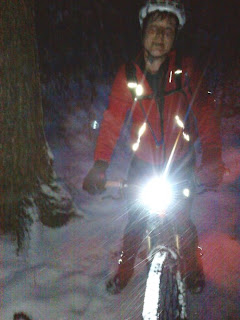- One who rides an off-road bicycle specially designed for travel on snow, sand or other loose terrain and characterized by extremely large, high flotation tires.
- A cyclist who is overweight, lazy, or otherwise slovenly or sloth-like. Often found sitting on their couch drinking beer or on the internet touting the virtues and versatility of their unused fat bike.
 |
| Not the best idea lately. |
Even before the first snow flew this fall we started to see roving bands of people plodding along through the dry leaves on their Fat Bikes. Purchase justification of another purpose specific bicycle I guess. When the first snows finally came in January of this year, all of three inches of fluff, their were out like bands of roving Gypsies. How do I know? Because I saw them out while we were all out riding our traditional MTBs through the ankle deep snow, the same as we had since we started mountain biking. Even after we got deeper snow which quickly got packed in and froze up we were able to ride. All through January in fact and into February of this year the traditional mountain biking was reasonably good.
The reality is that a few inches of fluff is fine for a traditional MTB. Sure, it is a little slick but not bad. The issue is when you get more than a few inches or when the fluff is more like wet cement. Then the traditional 2.1" MTB tire plows and makes going difficult or impossible. There is a point in fact, right around that mark, where narrower cyclocross tires actually cut through better than a wider tire, making for less rolling resistance from the snow. With a cross bike in powder you can actually ride through quite a bit of snow without much trouble. Again though, when it gets wet all bets are off. Then you need the float and that is where the 4" tires of a Fat Bike make sense. Still, they can only handle slightly more extreme conditions than a regular bike.
 |
| Not seeing any Fat Bike tracks. |
A couple of weeks ago we went and tried the trails on MTB as we'd had a bunch of thaw/freeze cycles as well as rain. Unfortunately the trails with the most foot traffic, which is actually ideal for compacting the trail to the point where it is rideable on a traditional MTB, had turned to ice. That required studded tires. Other parts of the trail that had seen little foot traffic were still too deep and loose to ride. Back to the road again.
 |
| This sucks sweaty monkey nuts. |
We rode in what has become one of the most highly used MTB areas around yet through all of this we saw no Fat Bike tracks at all. The trails were not packed smooth by the bulging high-flotation tires piloted by their fit and healthy owners who, unlike the rest of the cycling community, had continued to ride out of doors through the tough New England winter. This left we wondering where they had all gone to when the weather turned and if the snow was not what they were searching for, what drove the necessity for the bikes? I guess that they are all just "Gettin' Fat".
I guess it just the same old same old and the same reason we can't seem to get people to do a two hour weeknight road ride in freezing temperatures. Soft. I honestly think that this is the perfect year for a Fat Bike. I'm wishing that we had some in reality. Maybe the used market will be good when all of those Fat Bikers realize they don't really need the Fat Bikes. I know a couple of people up north who have been riding their Fat Bikes though. Good for them.
No comments:
Post a Comment